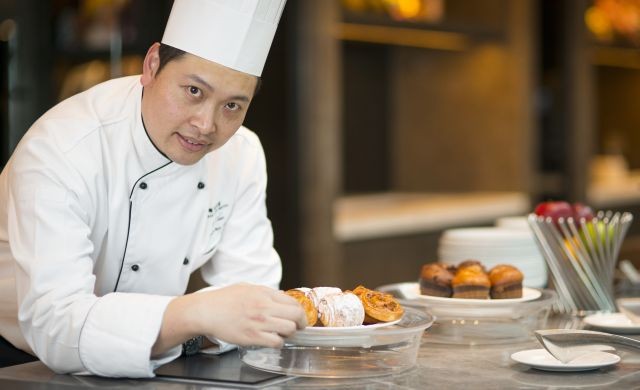
Is This a Crab or a Cake?
Right or wrong, keep the clay pot.
Hotels around town are gearing up for hairy crab season, but the Royal Plaza’s been plating up claypot crab congee. Except it’s not actually crab congee—it’s a cake. The hotel’s Executive Pastry Chef Roy Chan has been designing desserts disguised as popular Asian dishes, from “beef noodle” chocolate cake to “tempura ramen” mango custard cake. He takes Evelyn Lok through his confusing creations.
HK Magazine: When did the ideas for these cakes begin?
Roy Chan: I didn’t specifically set out to make this series of cakes. The idea behind it was a discussion with colleagues on how to make more interesting cakes, since nowadays people usually “eat with their cameras first”—when you present the dish everyone whips out their phone to snap photos. Personally, I actually like simpler desserts without that much decoration.
HK: How do you decide on what dishes to replicate?
RC: I make desserts from dishes that most people would have eaten or at least seen before, dishes that are instantly recognizable. For fall, we got our ideas from seasonal ingredients such as Okinawa purple sweet potato, chestnuts and crab.
HK: How do you make the toppings?
RC: It’s a challenge! I don’t want to rely on using fondant to shape them, so it takes more time to think of how to go about it, and it might also take longer to make the actual product. For instance, on top of traditional claypot rice there’s usually a vegetable garnish. For our recreation we brainstormed a lot of ways to recreate this. We ended up using buttercream, because piping it on top creates the best effect and it’s also the quickest.
HK: What’s wrong with making fondant toppings?
RC: If we used fondant it’d be easy. You could just roll out a shrimp tempura shape and dredge it in cake crumbs and that’s it. Fondant icing does look grander and is better for details, but it wouldn’t taste very good, plus people usually put it aside and won’t eat it. Instead, we had to think about what kinds of ingredients were durable enough, and what we could use to mimic the shapes of the actual toppings. Eating a chocolate crab shell is definitely better than having it in fondant! Plus, the most important part of making these cakes is how easy they are to make. A fondant cake could sell for $3,000-$4,000, but it would take at least two days to make one. We want to make it on a larger scale and don’t want to sell it at such a high price.

HK: What’s the hardest part of making these cakes?
RC: The toughest part was making the molds for certain toppings, such as the crab shell, so it would look consistent. We actually bought custom mold-making kits—the ones you use to make Gundam models—to create them.
HK: What has feedback been like from customers?
RC: Guests at the hotel and passersby have been curious: “How come there’s a bowl of noodles in the cake display case?” And there have even been requests to change toppings, with people saying “can I not have shrimps and have two abalone instead?” It’s like they turned the whole thing into a cart noodle shop! But custom orders are not impossible. We add a little extra money and if the customer is happy, we’re fine with it.
HK: What’s next, chef?
RC: I’ve always been thinking of making a sashimi rice cake—we already did a sushi dish before for a special promotion. For salmon we’d use layers of milk pudding and orange pudding, and for tuna we’d use raspberry juice.
Fool your friends with a “sweet surprise” cake (from $330 for a 1lb cake) from the Royal Plaza Hotel Cake Shop, 193 Prince Edward Rd. West, Prince Edward, 2928-8822, www.royalplaza.com.hk.

